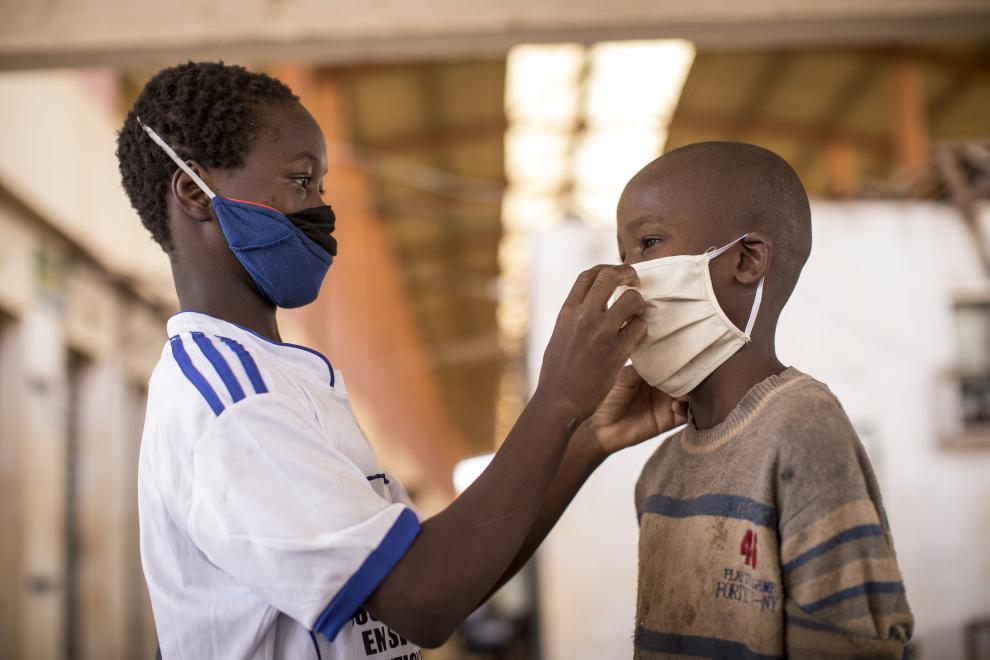How to Protect Vulnerable Populations From Viral Outbreaks

This article examines strategies for protecting vulnerable populations from viral outbreaks.
It aims to provide a comprehensive understanding of the risks faced by these populations and to identify key groups that are particularly vulnerable during such outbreaks.
Furthermore, the article explores the implementation of targeted prevention strategies, ensuring access to healthcare for vulnerable populations, and addressing socioeconomic challenges in protecting them.
Finally, it discusses the importance of building resilience and support systems within these communities.
Key Takeaways
- Mental health and cultural sensitivity are crucial in addressing risks faced by vulnerable populations during viral outbreaks.
- Immunocompromised individuals, older adults, socioeconomically disadvantaged communities, and racial and ethnic minorities are key vulnerable populations in viral outbreaks.
- Targeted prevention strategies tailored to at-risk groups, such as vaccination campaigns and increased access to testing and treatment, are crucial.
- Ensuring access to healthcare, overcoming language and cultural barriers, and incorporating cultural sensitivity into public health campaigns are important in protecting vulnerable populations from viral outbreaks.
Understanding the Risks Faced by Vulnerable Populations
The risks faced by vulnerable populations in relation to viral outbreaks are crucial to understand in order to effectively protect them.
Mental health and cultural sensitivity are key factors that need to be considered when addressing the risks faced by vulnerable populations during viral outbreaks.
Vulnerable populations, such as the elderly, individuals with pre-existing health conditions, and those living in poverty, are more susceptible to the negative impacts of viral outbreaks. These individuals may experience heightened anxiety, depression, and fear due to the uncertainty and potential consequences of the outbreak.
Moreover, cultural sensitivity is important in understanding how different populations may have unique needs and beliefs that should be taken into consideration when implementing protective measures.
Identifying Key Vulnerable Populations in a Viral Outbreak
Identifying key populations at risk during a viral outbreak is crucial for effective public health response. By understanding who is most vulnerable, resources and interventions can be targeted appropriately to ensure the highest level of protection for those who need it most. When identifying high-risk populations, it is important to consider various factors, including age, underlying health conditions, socioeconomic status, and access to healthcare.
Four key populations that should be assessed during a viral outbreak include:
- Immunocompromised individuals: Those with weakened immune systems, such as organ transplant recipients or individuals undergoing cancer treatment, are more susceptible to viral infections.
- Older adults: The elderly often have age-related declines in immune function, making them more vulnerable to severe illness and complications.
- Socioeconomically disadvantaged communities: Lower socioeconomic status can lead to limited access to healthcare, which may result in delayed or inadequate treatment during a viral outbreak.
- Racial and ethnic minorities: Assessing healthcare disparities among different racial and ethnic groups is crucial to ensure equal access to healthcare services and resources during a viral outbreak.
Implementing Targeted Prevention Strategies for Vulnerable Groups
Implementing evidence-based prevention strategies tailored to the specific needs of at-risk groups is crucial for reducing the transmission of infectious diseases and minimizing their impact on public health. Targeted intervention plays a vital role in protecting vulnerable populations from viral outbreaks.
By focusing on specific groups that are more susceptible to infection or face barriers to accessing healthcare services, targeted interventions can address the unique needs and challenges faced by these populations. This approach involves implementing prevention measures such as vaccination campaigns, increased access to testing and treatment, and education programs that are specifically designed for at-risk groups.
Additionally, community engagement is essential in ensuring the success of these interventions. By involving community leaders and members in the planning and implementation of prevention strategies, there is increased trust, understanding, and acceptance of these interventions, leading to better outcomes in protecting vulnerable populations from viral outbreaks.
Ensuring Access to Healthcare for Vulnerable Populations
This discussion will focus on the importance of healthcare equity for all.
Healthcare equity ensures that everyone, regardless of their socioeconomic status or background, has equal access to high-quality healthcare services.
The strategies for overcoming financial barriers to accessing healthcare involve implementing policies and programs that provide financial support to individuals who cannot afford healthcare expenses.
Addressing transportation challenges is crucial as lack of transportation can prevent individuals from reaching healthcare facilities and receiving timely medical attention.
Healthcare Equity for All
Ensuring healthcare equity for all is a critical aspect of protecting vulnerable populations from viral outbreaks.
Equitable access to healthcare is crucial in preventing the spread of infectious diseases, especially among marginalized communities.
Marginalized communities often face systemic barriers that limit their access to healthcare services, including lack of insurance coverage, limited healthcare facilities in their neighborhoods, and language or cultural barriers.
These factors contribute to health disparities and increase the vulnerability of marginalized populations to viral outbreaks.
To achieve healthcare equity, it is necessary to address these barriers and provide equal access to healthcare services for all individuals, regardless of their socioeconomic status or background.
This can be achieved through policies that promote affordable healthcare, increase the number of healthcare facilities in underserved areas, and improve cultural competency training for healthcare providers.
Overcoming Financial Barriers
Language barriers and cultural considerations can pose significant challenges in protecting vulnerable populations from viral outbreaks. Overcoming these barriers requires a multifaceted approach that addresses the unique needs and circumstances of different communities. One effective strategy is to provide accurate and accessible information in languages that are widely spoken within the community. This can be achieved through translation services, multilingual materials, and community outreach programs. Additionally, it is crucial to address cultural considerations when communicating health information. This involves understanding and respecting cultural norms, beliefs, and practices that may impact individuals’ perception of health and healthcare. By incorporating cultural sensitivity into public health campaigns, healthcare providers can effectively engage with vulnerable populations and ensure that they receive the necessary support and resources to protect themselves during viral outbreaks.
| Language Barriers | Cultural Considerations |
|---|---|
| Translation services | Understanding cultural norms |
| Multilingual materials | Respecting beliefs and practices |
| Community outreach programs | Incorporating cultural sensitivity |
| Accurate and accessible information | Engaging with vulnerable populations |
Addressing Transportation Challenges
Addressing transportation challenges during viral outbreaks requires a comprehensive approach that considers the accessibility and availability of transportation options for all individuals, particularly those in marginalized communities.
Public transportation alternatives play a crucial role in ensuring the movement of people while minimizing the risk of viral transmission. These alternatives include increasing the frequency and capacity of buses and trains to allow for social distancing, implementing rigorous cleaning and disinfection protocols, and providing hand sanitization stations.
Additionally, community outreach efforts are essential to inform individuals about the available transportation options and to address any concerns or barriers they may face. This can be achieved through targeted communication campaigns, partnerships with community organizations, and the establishment of helplines or dedicated transportation assistance programs.
Addressing Socioeconomic Challenges in Protecting Vulnerable Populations
Mitigating the socioeconomic challenges faced by vulnerable populations is crucial in effectively protecting them from viral outbreaks. Socioeconomic inequalities exacerbate the vulnerability of marginalized communities, making them more susceptible to the negative impacts of viral outbreaks.
In order to address these challenges, the following strategies should be considered:
- Enhancing access to healthcare: Providing affordable and accessible healthcare services to marginalized communities can help ensure early detection, timely treatment, and effective management of viral outbreaks.
- Strengthening social support networks: Creating and strengthening social support systems can help vulnerable populations cope with the socioeconomic impacts of viral outbreaks. This can include providing financial assistance, food security, and access to essential resources.
- Promoting education and awareness: Improving health literacy and raising awareness about preventive measures can empower marginalized communities to protect themselves from viral outbreaks. This can be achieved through community outreach programs, culturally sensitive information campaigns, and targeted education initiatives.
Building Resilience and Support Systems for Vulnerable Communities
Building resilience and support systems for marginalized communities is essential in ensuring their ability to withstand and recover from the socioeconomically adverse impacts of public health crises. Resilience building involves empowering these communities to develop the capacities and resources necessary to cope with and adapt to the challenges they face.
Community support plays a crucial role in this process by providing a network of assistance and resources to bolster the resilience of vulnerable populations. This support can take many forms, including access to healthcare services, financial assistance, educational opportunities, and social support networks.
Frequently Asked Questions
How Can Vulnerable Populations Be Identified in a Viral Outbreak?
Identifying vulnerabilities in a viral outbreak requires a systematic approach that considers various factors such as age, underlying health conditions, socioeconomic status, and access to healthcare. Targeted interventions can then be implemented to address the specific needs of these vulnerable populations.
What Are Some Specific Prevention Strategies That Can Be Implemented for Vulnerable Groups?
Prevention strategies aimed at protecting vulnerable populations from viral outbreaks can include the implementation of targeted outreach programs that provide education, access to healthcare services, vaccinations, and hygiene supplies.
How Can Access to Healthcare Be Ensured for Vulnerable Populations During a Viral Outbreak?
Ensuring equity in access to healthcare for vulnerable populations during viral outbreaks requires comprehensive outreach and education strategies. By targeting these groups with tailored interventions, healthcare systems can address their specific needs and improve overall health outcomes.
What Are Some Specific Socioeconomic Challenges That Need to Be Addressed in Protecting Vulnerable Populations?
Addressing socioeconomic challenges is crucial in ensuring healthcare access for vulnerable populations. These challenges may include limited financial resources, lack of education, inadequate housing, and limited access to transportation, which can hinder their ability to seek and receive timely medical care.
How Can Resilience and Support Systems Be Built for Vulnerable Communities in the Face of a Viral Outbreak?
Building community and empowering individuals are essential factors in creating resilience and support systems for vulnerable communities. These strategies help strengthen their ability to cope with and mitigate the impacts of viral outbreaks.








